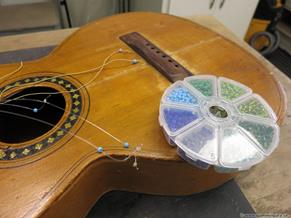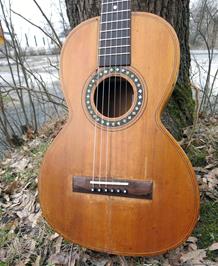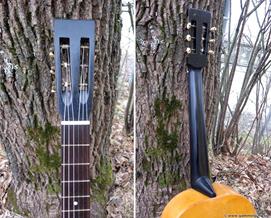My clients are either musicians who like old instruments and who want to get an old guitar playable or it is genealogy that needs to be repaired. This belongs to the latter category. The guitar was bought and played by her grandfather who was tragically injured at the age of 36 in 1914 in a workplace accident at the Husum factory not far from Örnsköldsvik. From the look I dated it to about 1900 and it matches the story very well. Until the mid-1920s, the guitar was lent out to a free-church association occasionally. It was probably when it received its damage and repairs. Since then, it has been in the family as a memory without being played, but now it will come back to use.
The fact that it is a little older can be seen mainly on the old tuning screws. Around 1900 they were more robustly manufactured with the string post below the rack and of better quality than in the 1920-1930s. These were in good condition, especially as the gap almost disappears when the strings are tightened. The fact that it is completely blonde on the side and back is also a sign of age, around 1910 they are often vein painted. The guitar was a little bigger than usual and had a wider edge. That and having a grip board in Brazilian rosewood suggests that it was a bit more expensive for its time. It was completely unmarked, but probably built in Germany.
It was not in the best condition, the throat had slammed and the halfot cracked while parts of the lid under the grip board were pressed into the sound hole. The stable was not in the best condition either, they had glued on it in a clumsy way and damaged the lid around the stable. The bottom had a couple of larger cracks and also the lid. The guitar had been lacquered with a lap of alcohol lacquer and not in a good way, especially the lid had an uneven lacquer surface.
Had to spend a little more time than usual on repairing the damage. During the stable, a piece of the lid was taken around the string pins, folded in a piece of spruce. The worst crack in the lid got a stick in spruce glued. Got loose on the lid along the edge around the neck attachment to force back the piece of the lid that was pressed into the sound hole and glued to an old repair. The back of the neck had marks of a capo, and the neck foot had an angled brass angle to hold the cracked neck foot together. The brass angle and pits after the capot were filled in with new wood, abrasive dust and glue before the entire neck was painted black with alcohol varnish. Feels good to be able to hide all repairs with black paint!
Measured up the fine grip board and it turned out that the straps hardly sat in the right place. The 5th band was e.g. placed 2,5 mm too high on the neck 🙂 Filled in all the band cuts with rosewood strips glued with skin glue and traced it right before I banded on with new brass bands.
Made a new replica figure in rosewood to replace the old one in soft birch / maple painted with black.
The ribbing was made smaller than usual for the nylon strings without ribs behind the stable.
Because the stable had string sticks, plugs were mounted and I also made a composite stable leg, although the last was a little overpriced on a nylon string guitar. Got a tip by Per Hallgren to use glass balls with holes as string balls on the nylon strings. Bought them at Panduro, which has some interesting gadgets among all things. Worked very well, the balls are soft, light and fine and can be reused at the next strand change. No overspending was done.
Feels good to be able to help revitalize a guitar with such a strong history. I hope it will be played and appreciated for as long as possible!















